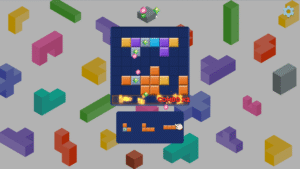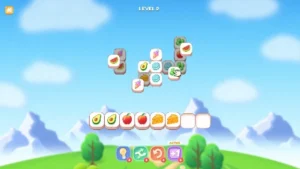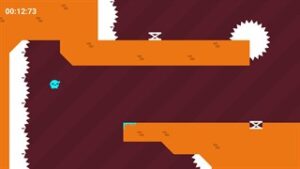If you’ve been hanging around the indie gaming scene lately, you might have stumbled across Blocky Blast—a colourful, addictive little puzzler that feels like a love letter to classics like Tetris. But who’s behind it? That would be Webnetic s.r.o., a small but mighty studio based in Turany, Slovakia. (Check out our review of Blocky Blast at the bottom of the Q & A)
We sat down with some questions to learn more about their journey, their philosophy, and where they’re headed next.
Who is Webnetic?
Q) So, let’s start simple: for folks who might not know you yet, how would you introduce Webnetic in your own words?
A) Webnetic is a small, agile team from Slovakia. We originally began as an IT company, but over time our passion led us into the gaming industry. Our journey started on PlayStation, later expanding to Nintendo and Xbox, and most recently exploring the Atari VCS platform. We focus on creating smaller, affordable titles that bring fun and accessibility to a wide audience. At the same time, as our experience and resources grow, we are gradually moving toward more ambitious projects, expanding the scale and depth of our games while maintaining the same dedication to quality and creativity.
Q) You describe yourselves as a “small, agile team.” What does that look like on a day-to-day basis—late nights, coffee runs, lots of brainstorming sessions?
A) At Webnetic, it’s not about closing the laptop at 5 PM. We keep working until things are done or until we simply can’t push any further. That’s how it’s been for us from the very start, because we enjoy what we do, and we always want to finish things properly.
Q) You’re based in Turany, Slovakia. How has your home base shaped the way you work and create?
I do not think that this has done anything in our work…
Making Games the Webnetic Way
Q) A lot of your titles are cozy, approachable, and easy to pick up—whether it’s a puzzler, a light platformer, or even a visual novel. Why do you think “accessible fun” is such an important part of your identity?
A) We think that not everyone likes everything, therefore we would love to make something for everyone, even if they are younger or older.
Q) We’ve seen everything from puzzle adventures to family-friendly games in your catalogue and even heard whispers of a VR project. Do you see yourselves as genre explorers, or is there a common thread tying all these projects together?
A) Our thinking is that we are trying all genres, and we love to try something new every time. This is moving you forward, if you are stacked at one place and doing the same thing repeatedly, you’re not advancing.
Q) You’ve gone through the certification process for PlayStation, Xbox, Nintendo Switch, and even the Atari VCS—that’s no small feat! What was that experience like for such a lean team?
A) If you check out our page, you’ll see that we’ve taken on a new platform almost every year, so for us it never felt like too much. Sometimes it was an amazing feeling that pushed us forward, but of course there were also tough challenges we had to overcome. Being such a small team meant that when problems came up, there was no one else to solve them—we had to handle everything ourselves. On the positive side, each platform also has supportive people who are willing to help, and that’s been a huge plus along the way.
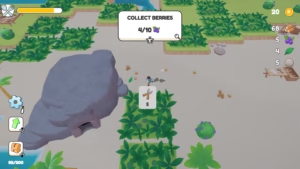
Taking Care of Players
Q) One thing that stands out about you guys is how much you care about players after a game is out—quick patches, clear changelogs, responsive support. Why is that level of polish and communication so important to you?
A) We believe this is one of the key things that keeps players engaged with our games, they can rely on us to fix issues and improve the experience even after release. We always try to deliver updates as quickly as possible, prioritizing titles with serious problems so that the gameplay remains solid. At the same time, we’re constantly working on improving our internal systems so we can respond faster. Of course, it doesn’t always go perfectly, and some rare issues can take us quite a while to solve, but we do our best to reduce that and keep pushing updates that players can count on.
Q) On your website, you also highlight accessibility and comfort—things like smooth frame pacing and optimized downloads. How do you build those values into your games from the ground up?
A) Through thorough testing, iteration, and constant optimization, we try to make sure our games feel smooth and comfortable to play. In some titles, we’ve also implemented accessibility features like colourblind modes to support more players. A good example is our game Colourful Boi and its upcoming sequel, which we’re planning to release on Xbox in the coming months. With these projects, we started focusing more deeply on accessibility, and thanks to Xbox providing us with a free accessibility audit, we received a full report and guidance on how to improve. That process really helped us better understand the challenges some players face, and how we can address them more effectively in our future games. The game includes several features that players with accessibility needs can truly appreciate, and we’re committed to building on that foundation going forward.
Q) And then there’s your mobile app, which lets players track your releases, set calendar alerts, and manage their library. What made you decide to build something like that?
A) We thought that some of our players would love to have that feature to track the games which were released and which will be released.
Business, Bundles & Being Seen
Q) Let’s talk pricing. Blocky Blast is just £2.49 in the UK, which is fantastic value. What’s your philosophy when it comes to making your games affordable?
A) We think a lot of our players just want to sit down and relax, without spending too much. We also understand that not everyone around the world can afford higher prices for games. That’s why we focus on making titles that are affordable and accessible for everyone, while keeping them fun and worth the time.
Q) You’ve also experimented with bundles, like the Blocky Blast Triple Pack. Was that mainly about giving players more content, or also about experimenting with how indies can stand out?
A) This topic is quite relevant on Xbox right now. We had several reasons for trying bundles one of them was definitely experimentation, because as a small indie team we don’t always have enough data across multiple games to make the best decisions. Another reason was discounts: when we release games, we like to put them on sale, and the bundle format made that much easier to set up. Plus, it’s more convenient for players since they don’t need to add every single version of the game to the cart separately.
Q) Marketing can be tough in a crowded indie landscape. How do you approach getting eyes on your games?
A) Our main strategy is to get in touch with people on social media and use all the possibilities we can use.
Looking to the Future
Q) You’ve teased a VR project—that’s exciting! What drew you to step into VR, and can you give us any hints about what to expect?
A) We have always wanted to try some VR games. We have already tried to develop one VR puzzle game, but it did not go as well as we planned :D… But after some time, we are trying to make the VR again. So, stay tuned and follow us on the socials to know more about the game.
Q) Are there more puzzle or platform adventures in the pipeline, or maybe something completely different?
A) We are trying to put out games every month but sometimes it is hard. We are working hard every day, but I cannot tell you what to expect but I can just say to follow us on the socials
Q) How do you see Webnetic growing over the next few years—do you imagine building a bigger team, branching into new genres, or staying small and nimble?
A) To be honest, we’ve already tried bringing in some new people, but it didn’t go very well, so for now we’re staying small and nimble. The current times also don’t make it easier—many studios are letting people go, and the cost of various licenses needed for games has gone up over the years. By keeping the team small, we can react more flexibly to these challenges and keep the company financially healthy.
For Fun
Q) What’s been your favourite project to work on so far, and why?
A) We think the VR projects are fun and challenging, because you are learning something new that is not seen in normal games.
Q) Any funny behind-the-scenes stories from development—bugs, accidents, or happy mistakes that turned into features?
A) A lot depends on the mood and the day. Sometimes everything goes smoothly, and we just enjoy our coffee while coding. Other times, the coffee ends up on the floor instead of the cup it has happened more than once! During VR development, we’ve also had a few accidents where the headset slipped and fell, but thankfully it survived every time. And then there are those long nights when we’re chasing a bug for hours, only to finally discover the cause and fix it with just a couple of clicks.
Q) Dream collaboration time: if you could partner with any other developer or studio in the world, who would it be?
A) For me it would be Take2, 2K or DICE.
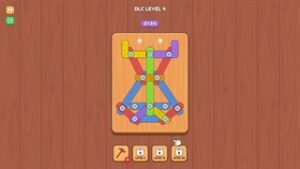
Wrapping Up
Webnetic may be small, but they’ve carved out a clear identity: games that are accessible, polished, and fun to play across all platforms. From Blocky Blast to whatever their next VR adventure turns out to be, they’re a studio worth keeping an eye on. Please visit the Webnetic website by clicking on the link here.
Blocky Blast Review – A Modern Twist on a Classic Puzzle Formula



